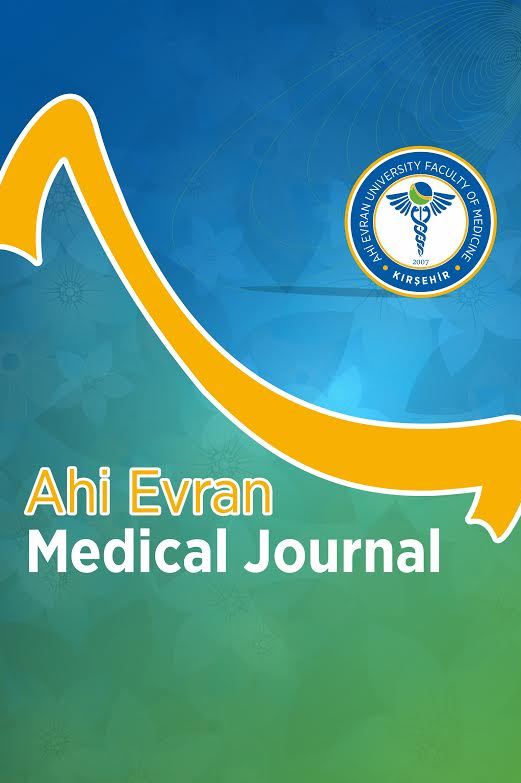COVID-19 Nüks, Reenfeksiyon Sıklığı ve Vakaların Klinik Özellikleri
epidemiyoloji, SARS-CoV-2, pandemi
COVID-19 Relapse and Reinfection Frequency, Clinical Features of Cases
epidemiology, pandemic, SARS-CoV-2,
___
- 1. Siracusano G, Pastori C, Lopalco L. Humoral Immune Responses in COVID-19 Patients: A Window on the State of the Art. Front Immunol. 2020;11:1049.
- 2. García LF. Immune Response, Inflammation, and the Clinical Spectrum of COVID-19. Front Immunol. 2020;11:1441.
- 3. Li G, Fan Y, Lai Y, et al. Coronavirus infections and immune responses. J Med Virol. 2020;92(4):424-432.
- 4. Mo H, Zeng G, Ren X, et al. Longitudinal profile of antibodies against SARS-coronavirus in SARS patients and their clinical significance. Respirology. 2006;11(1):49-53.
- 5. Payne DC, Iblan I, Rha B, et al. Persistence of antibodies against middle east respiratory syndrome coronavirus. Emerg Infect Dis. 2016;22(10):1824-1826.
- 6. Gousseff M, Penot P, Gallay L, et al. Clinical recurrences of COVID-19 symptoms after recovery: Viral relapse, reinfection or inflammatory rebound? J Infect. 2020;81(5):816-846.
- 7. Investigative criteria for suspected cases of SARS‐CoV‐2 reinfection (ICR).2020. https://www.cdc.gov/ coronavirus/2019-ncov/php/invest-criteria.html Access date April 15, 2021.
- 8. Jones NK, Rivett L, Sparkes D, Forrest S, et. al. Effective control of SARS-CoV-2 transmission between healthcare workers during a period of diminished community prevalence of COVID-19. eLife. 2020;9:e59391.
- 9. Tillett RL, Sevinsky JR, Hartley PD, et al. Genomic evidence for reinfection with SARS-CoV-2: a case study. Lancet Infect Dis. 2021;21(1):52-58.
- 10. Garcia-Beltran WF, Lam EC, Astudillo MG, et al. COVID-19-neutralizing antibodies predict disease severity and survival. Cell. 2021;184(2):476-488.
- 11. Bentivegna E, Sentimentale A, Luciani M, Speranza ML, Guerritore L, Martelletti P. New IgM seroconversion and positive RT-PCR test after exposure to the virus in recovered COVID-19 patient. J Med Virol. 2021;93(1):97-98.
- 12. Sheehan MM, Reddy AJ, Rothberg MB. Reinfection Rates among Patients who Previously Tested Positive for COVID-19: a Retrospective Cohort Study. Clin. Infect. Dis. 2021;73(10):1882-1886.
- 13. Pilz S, Chakeri A, Ioannidis JPA, et al. SARS-CoV-2 re-infection risk in Austria. Eur J Clin Invest. 2021;51(4):1-7.
- 14. Salehi M, SeyedAlinaghi S, Alavi Darazam I, et al. COVID-19 Reinfection or Relapse? A Retrospective Multicenter Cohort Study from Iran. Arch Clin Infect Dis. 2021;16(5):e116381.
- 15. Ye G, Pan Z, Pan Y, et al. Clinical characteristics of severe acute respiratory syndrome coronavirus 2 reactivation. J Infect. 2020;80(5):14-17.
- 16. Liu H, Chen S, Liu M, Nie H, Lu H. Comorbid chronic diseases are strongly correlated with disease severity among COVID-19 patients: A systematic review and meta-analysis. Aging Dis. 2020;11(3):668-678.
- 17. Adrielle dos Santos L, Filho PG de G, Silva AMF, et al. Recurrent COVID-19 including evidence of reinfection and enhanced severity in thirty Brazilian healthcare workers. J Infect. 2021;82(3):399-406.
- 18. Alkundi A, Mahmoud I, Musa A, Naveed S, Alshawwaf M. Clinical characteristics and outcomes of COVID-19 hospitalized patients with diabetes in the United Kingdom: A retrospective single centre study. Diabetes Res Clin Pract. 2020;165:108263.
- 19. Bruni M, Cecatiello V, Diaz-Basabe A, et al. Persistence of anti-SARS-CoV-2 antibodies in nonhospitalized COVID-19 convalescent health care workers. J. Clin. Med. 2020;9(10):3188.
- 20. Lumley SF, O’Donnell D, Stoesser NE, et al. Antibody Status and Incidence of SARS-CoV-2 Infection in Health Care Workers. N Engl J Med. 2021;384(6): 533-540.
- 21. Lechien JR, Chiesa-Estomba CM, Radulesco T, et al. Clinical features of patients who had two COVID-19 episodes: a European multicentre case series. J Intern Med. 2021;290(2):421-429.
- 22. Dan JM, Mateus J, Kato Y, et al. Immunological memory to SARS-CoV-2 assessed for up to 8 months after infection. Science. 2021;371(6529):4063.
- 23. UK Biobank. UK Biobank SARS-CoV-2 serology study.https://www.ukbiobank.ac.uk/media/x0nd5sul/ukb_serologystudy_report_revised_6months_jan21.pdf. Access date April 23, 2021.
- 24. Udwadia ZF, Singh P, Barkate H, et al. Efficacy and safety of favipiravir, an oral RNA-dependent RNA polymerase inhibitor, in mild-to-moderate COVID-19: A randomized, comparative, open-label, multicenter, phase 3 clinical trial. Int J Infect Dis. 2021;103:62-71.
- 25. Ip A, Ahn J, Zhou Y, et al. Hydroxychloroquine in the treatment of outpatients with mildly symptomatic COVID-19: A multi-center observational study. medRxiv. BMC Infect. Dis. 2021;21(1):1-12.
- Yayın Aralığı: Yılda 3 Sayı
- Başlangıç: 2017
- Yayıncı: Kırşehir Ahi Evran Üniversitesi
Bell Paralizisi Olan Hastalarda Hematolojik Parametrelerin Prognostik Değeri Var Mıdır?
Muhammed Gazi YILDIZ, İsrafil ORHAN, İrfan KARA, Saime SAĞIROĞLU, Nagihan BİLAL, Adem DOĞANER, Muhammed SEYİTHANOĞLU
Doktorlarda Sigara Bağımlılığı: Anadolu’dan Kesitsel
Serebral Palsili Çocuğu Olan Ebeveynlerde Bakım Yükü, Psikolojik Durum ve Yaşam Kalitesi İlişkisi
Esra GÜNDEDE, Emre ŞENOCAK, Aysel Yıldız ÖZER
Kronik Ürtiker Hastalarında Fibromiyalji Sendromu Sıklığının Değerlendirilmesi
Fatih DEMİRCİ, Abdulsamet TANIK
Median Sinir Fibrolipomatöz Hamartomu: Olgu Sunumu
Seyyid Şerif ÜNSAL, Hatice KAPLANOĞLU, Veysel KAPLANOĞLU, Ayten LİVAOGLU
Burak TAN, Ercan BABUR, Umut BAKKALOĞLU, Ayşenur ÇİMEN, Cem SÜER, Meral AŞÇIOĞLU
Çocukluk Çağı Adenoid Dokusu ve Deri Altı Yağ Dokusu İlişkisinin MRG Kullanılarak Değerlendirilmesi
Mehmet ŞİRİK, Mehtap KOPARAL, İbrahim BUCAK
Funda EREN, Esra FIRAT OĞUZ, Salim NEŞELİOĞLU, Rıdvan FIRAT, Osman İNAN, Emin GEMCİOĞLU, Enes ŞAHİNER, İhsan ATEŞ, Özcan EREL
